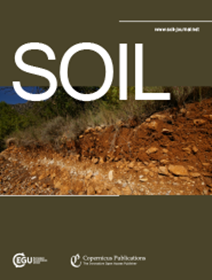Mineral-bound organic carbon exposed by hillslope thermokarst terrain: case study in Cape Bounty, Canadian High Arctic
IF 4.3
2区 农林科学
Q1 SOIL SCIENCE
引用次数: 0
Abstract
Abstract. Arctic landscapes could add 55–230 Pg of carbon (in CO2 equivalent) to the atmosphere, through CO2 and CH4 emissions, by the end of this century. These estimates could be quantified more accurately by constraining the contribution of rapid thawing processes such as thermokarst landscapes to permafrost carbon loss, and by investigating the exposed organic carbon (OC) interacting with mineral surfaces or metallic cations, i.e., the nature of these interactions and what controls their relative abundance. Here, we investigate two contrasted types of hillslope thermokarst landscapes: an Active Layer Detachment (ALD) which is a one-time event, and a Retrogressive Thaw Slump (RTS) which repeats annually during summer months in the Cape Bounty Arctic Watershed Observatory (Melville Island, Canada). We analyzed mineralogy, total and soluble element concentrations, total OC and mineral-OC interactions within the headwalls of both disturbances, and within corresponding undisturbed profiles. Our results show that OC stabilized by chemical bonds account for 13 ± 5 % of total OC in the form of organo-metallic complexes and up to 6 ± 2 % associated with poorly crystalline iron oxides. If we add the mechanisms of physical protection of particulate organic matter in aggregates and larger molecules stabilized by chemical bonds, we reach 64 ± 10 % of the total OC being stabilized. Importantly, we observe a decrease in the proportion of mineral-bound OC in the deeper layers exposed by the retrogressive thaw slump: the proportion of organo-metallic complexes drops from ~18 % in surface samples to ~1 % in the deepest samples. These results therefore suggest that the OC exposed by thermokarst disturbances at Cape Bounty is protected by interactions with minerals to a certain extent, but that deep thaw features could expose OC more readily accessible to degradation.由山坡热岩溶地形暴露的矿物结合有机碳:加拿大高北极邦蒂角的案例研究
摘要。到本世纪末,北极景观可能会通过二氧化碳和甲烷的排放向大气中增加55 - 230pg的碳(二氧化碳当量)。通过限制快速融化过程(如热岩溶景观)对永久冻土碳损失的贡献,以及通过调查暴露的有机碳(OC)与矿物表面或金属阳离子的相互作用,即这些相互作用的性质以及控制它们相对丰度的因素,可以更准确地量化这些估计。在这里,我们研究了两种不同类型的山坡热岩溶景观:一次活动层剥离(ALD),这是一个一次性事件,以及每年夏季在邦蒂角北极分水岭观测站(加拿大梅尔维尔岛)重复发生的退行性融化滑坡(RTS)。我们分析了矿物学、总和可溶性元素浓度、总有机碳和矿物-有机碳相互作用,这些都发生在两种干扰的顶壁和相应的未受干扰的剖面中。我们的研究结果表明,化学键稳定的有机碳以有机金属配合物的形式占总有机碳的13±5%,高达6±2%的有机碳与结晶性差的氧化铁有关。如果加上聚集体和化学键稳定的大分子颗粒有机质的物理保护机制,我们可以达到总OC的64±10%。重要的是,我们观察到,在后退性融化滑坡暴露的较深层中,矿物结合OC的比例有所下降:有机金属配合物的比例从表层样品的~ 18%下降到最深处样品的~ 1%。因此,这些结果表明,在热岩溶扰动下暴露的OC在一定程度上受到矿物相互作用的保护,但深度解冻特征可能使OC更容易暴露于退化。
本文章由计算机程序翻译,如有差异,请以英文原文为准。
求助全文
约1分钟内获得全文
求助全文
来源期刊

Soil
Agricultural and Biological Sciences-Soil Science
CiteScore
10.80
自引率
2.90%
发文量
44
审稿时长
30 weeks
期刊介绍:
SOIL is an international scientific journal dedicated to the publication and discussion of high-quality research in the field of soil system sciences.
SOIL is at the interface between the atmosphere, lithosphere, hydrosphere, and biosphere. SOIL publishes scientific research that contributes to understanding the soil system and its interaction with humans and the entire Earth system. The scope of the journal includes all topics that fall within the study of soil science as a discipline, with an emphasis on studies that integrate soil science with other sciences (hydrology, agronomy, socio-economics, health sciences, atmospheric sciences, etc.).
 求助内容:
求助内容: 应助结果提醒方式:
应助结果提醒方式:


